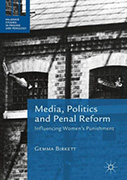Media, Politics And Penal Reform: Influencing Women’s Punishment

Author: Gemma Birkett
Publisher: Cham, SWIT: Palgrave, 2017. 205p.
Reviewer: Russ Immarigeon | March 2019
For over a century, British reform groups have struggled to improve the conditions and consequences of incarceration for women flowing through the country’s criminal justice system. In recent decades, national reform groups have been especially active in challenging the incarceration of women, with many now advocating for the abolition of women’s prisons.
Media, Politics and Penal Reform, notes City University of London criminologist Gemma Birkett, “cast[s] light on the particular difficulties experienced by those working to reform women’s penal policy. In so doing, [she] recognizes the number of complexities inherent to the policy process, including the political culture and dominant ideology of the time (acting as an enabler or inhibitor to policy change); the ‘carrying capacity’ of the institutional agenda; the framing and (re)construction of competing messages and the omnipresent threat of public opinion.”
Accordingly, Media, Politics and Penal Reform attempts to uncover “the forces that shape women’s penal network, with particular focus on the political decision-makers working to develop policy, the campaigners lobbying to influence it, the journalists providing a continued (and often critical) commentary of it and the public who (whether knowingly or not) help to shape its future direction.”
Birkett’s investigation into the influencing of women’s punishment was conducted between 2010 and 2015 using academic, historical and public documents, including ministerial speeches, governmental policy reports and campaign group-produced literature, as well as semi-structured interviews with campaigners, 10 journalists and 35 former government officials and civil servants.
In reporting the results of her inquiry, Birkett offers separate chapters on the study of penal policy, the framing and political power associated with competing penal philosophies in the aftermath of World War II, the diversity of efforts to influence women’s penal policy, the various approaches of penal reformers concerned with the plight of incarcerated women, the development of media ownership and differing journalist approaches toward covering crime and confinement, the internal working dynamics of official policy-makers, and “a summary of the interrelations between campaigners, journalists and political decision-makers at the media-policy nexus.”
Birkett’s chapter on the politicization of women’s penal policy is a detailed and instructive historical overview – from the early 19th century to the early 21st century – of campaign group and governmental efforts to reform – and even abolish – women’s imprisonment. While this topic deserves lengthier coverage – no doubt a book of its own – Media, Politics and Penal Reform is limited in the extent of its exploration of women’s prison reform groups and campaigns by its emphasis on a thinly stretched intersection of ideas, ideology and institutions.
Key findings stemming from Birkett’s interviews with campaigners, journalists, and policymakers include the following:
- Women’s prison reform campaigners expressed repeated frustration about news coverage. According to Birkett, “campaigners operated as marginalized news sources.” Their strategies to gain greater coverage of the plight of women prisoners rarely changed over recent decades. These campaigners tended to rely on traditionally redundant reformist messages and their tactics, including public demonstrations and organizational press releases, did little to encourage support from right-leaning, agenda-setting media, which were more interested in sensationalizing criminal justice for commercial or political gain. Some campaigners stressed their involvement with prison policy-makers (being consulted with and receiving advanced notice of governmental policy proposals). Others were less optimistic. “Whatever their status,” Birkett notes, “it was clear that strategies to influence change by traditional, private methods remained the main focus for penal reformers.”
- Journalists operating across the left-right political spectrum reported limited interest in the reform or abolition of women’s imprisonment. Beyond individual interest, there was, too, editorial interest, which was also lean on this topic. Birkett, stating that such stances are not especially new, seemed surprised that left-wing journalists also “questioned the effectiveness of reformist messages in their current form, and believed that campaigners needed to work more with their right-leaning colleagues to raft their messages into more news friendly packages.” Still, journalists did not feel that harder work alone would necessarily improve campaigners’ access to the media or the media’s coverage of campaigners’ concerns.
- Policy-makers interviewed for this study felt that neither campaigner nor media pressure was influential in determining their policy strategies, which were guided, they report, by their own inclinations. Still, some officials noted the importance of skilled media campaigns, campaign group affiliations with those not the usual suspects, and campaigners help in educating journalists about prison conditions and issues. Policy-makers generally eschewed media strategies and, curiously, they too had difficulties gaining media attention for their concerns, which were often deemed not newsworthy.
Birkett concludes that prison reform campaign-based communications strategies are only effective when embraced by journalists and their editors. Her informants noted that a “tendency for ‘lazy journalism’ in this area was viewed as a key barrier to progressive policy change. While many campaigners were aware that the messages they sought to publicize were not deemed newsworthy by journalists, it is unfortunate that this did not result in a fundamental rethink of their strategies.”
Overall, Birkett’s study is a rare empirical evaluation of the work done by penal reform-oriented advocates and campaigners. In the United Kingdom, Mick Ryan’s 1978 study The Acceptable Pressure Group (Saxon House) was a ground-breaking examination of competing reform groups – the still active Howard League for Penal Reform and the regrettably-defunct Radical Alternatives to Prison. Paul Rock’s deeply-detailed historical accounts of Crown Court operations, women’s prison construction, and crime victim rights are also models for examining reform initiatives. But such efforts are generally lacking, especially- sadly – in the United States.
Russ Immarigeon reviews books for Civic Research Institute publications covering corrections management, sexual assault, and community corrections.


